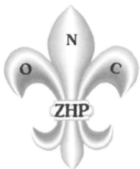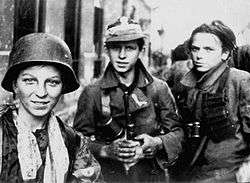Polish Scouting and Guiding Association
| The Polish Scouting and Guiding Association | |||
|---|---|---|---|
 | |||
| Polish: Związek Harcerstwa Polskiego | |||
| Headquarters | ZHP Headquarters Warsaw | ||
| Location | Warszawa, Konopnickiej 6 | ||
| Country | Poland | ||
| Founded | 1 November 1918 | ||
| Founder | Andrzej Małkowski, Olga Małkowska | ||
| Membership | 138,112 | ||
| Affiliation | World Organization of the Scout Movement, World Association of Girl Guides and Girl Scouts | ||
|
| |||
|
Website http://www.zhp.pl/ | |||
The Polish Scouting and Guiding Association (Polish: Związek Harcerstwa Polskiego, ZHP) is the coeducational Polish Scouting organization recognized by the World Organization of the Scout Movement and the World Association of Girl Guides and Girl Scouts. It was founded in 1918 and currently is the largest Scouting organization in Poland (138,112 members in 2012).[1][2] The first ZHP was founded in 1916, the current one is the fourth organization with this name. It is a public benefit organization as defined by Polish law.
History
Pre-war history
The Polish Scout movement was started in 1910. Initially the ideas of Scouting were implemented by Andrzej Małkowski and his wife Olga. The three main branches of Polish Scouting included the Strzelec paramilitary organization for boys, a sport and education society Sokół and the anti-alcoholic association Eleusis. However, it wasn't until the Partitions of Poland came to an end that the ZHP would be officially founded by the merging of existing groups.
Soon after the merger in 1918, the ZHP members fought in all the conflicts Poland was engaged in around this time: Great Poland Uprising, Polish-Bolshevik War, Silesian Uprisings, and Polish-Ukrainian War, much like their predecessors during the Siege of Mafeking.

All of the units joined together in 1918 and formed the ZHP, one of the founding members of the World Organization of the Scout Movement. Although many units retained their own traditions, a common law, common symbols and a common oath was introduced. The primary difference between most Scouting organizations and the Polish Harcerstwo was described by Andrzej Małkowski:
Harcerstwo is Scouting plus independence.
Before 1939 the ZHP was one of the largest social and educational associations in Poland with over 200,000 members. Among the "sponsors" of Polish Harcerstwo were all the presidents of Poland and several high-ranking officers, including general Józef Haller.
Gray Ranks
- Main article: Gray Ranks

After the Invasion of Poland of 1939, the ZHP were branded criminals by Nazi Germany, who had executed many Scouts and Guides, along with other possible resistance leaders, but the ZHP carried on as a clandestine organization. In 1940, the Soviet Union executed most of the Boy Scouts held at Ostashkov prison.
The wartime Scouts evolved into the paramilitary Szare Szeregi (Gray Ranks), cooperating with the Polish underground state and the Armia Krajowa resistance. Older Scouts carried out sabotage, armed resistance, and assassinations. The Girl Guides formed auxiliary units working as nurses, liaisons and munition carriers. At the same time the youngest Scouts were involved in so-called small sabotage under the auspice of the Wawer organization, which included dropping leaflets or painting the kotwica sign on the walls. During Operation Tempest, and especially during the Warsaw Uprising, the Scouts participated in the fighting, and several Szare Szeregi units were some of the most effective in combat.
In 1945 the ZHP restored its former name and returned to public existence. However, the communist authorities of Poland pressured the organization to become a member of the Pioneer Movement and eventually it was banned in 1949, but was integrated into the Polish United Workers' Party, with most of its members now part of a new Soviet style Pioneer organization in two years time - the Scouts of the Working Youth of Poland (Organizacja Harcerska Związku Młodzieży Polskiej or ZMP-OH), which retained the motto while adopting Pioneer traditions of Eastern Bloc countries, save for the uniform. The only existing part of pre-war ZHP is the ZHP pgK, established to serve Polish Scouts outside their homeland.[3]
Modern history

In 1956, after Stalin's and Bolesław Bierut's death, the Polish United Workers' Party youth movement ZMP OH was transformed and renamed to ZHP. However the new ZHP did not consider itself as a continuation of the pre-war ZHP, but as a new organization (until 1980). After 1958 many pre-war instructors were removed from the new ZHP or marginalized (like Aleksander Kamiński) and the original oath, law, educational content and methods were changed (mention of God was removed from oath, Lenin introduced as a hero, the Bolshevik Revolution was commemorated, the brigades became co-educational similar to Eastern Bloc Pioneer associations). But the most visible change was the transformation from the Pioneer salute back to the two-finger salute.
Despite this, the Polish Scouting and Guiding Association became one of the very few official organizations that retained some independence from the communist party. Because of this, its growth was rapid, and in 1980 it had more than three million active members. The Polish Scouts were engaged in a variety of duties, varying from helping in the fields of the most poor regions to organizing the visits of Pope John Paul II. After the martial law was imposed in 1981 the ZHP was the only large social organization not to be banned. The "VIII ZHP Convention" even supported the martial law. However, many of its high-ranking officials were interned because of their involvement in the Solidarność movement, as well as several Scoutmasters.
In 1989 after the period of peaceful transformation began, many groups of instructors formed separate Scouting organizations (like the ZHR,[4] Stowarzyszenie Harcerstwa Katolickiego-Zawisza[5] or ZHP-1918[6]). These moves were prompted by political disagreements with the character of ZHP; they felt that its communist takeover left a permanent mark upon the organisation, and that the only way to effectively reform the movement was to found a new organisation. ZHR's founding will serve as an adequate example of this principle. After pope John Paul II's first pilgrimage to Poland in August 1980, some "non-conforming" instructors inside the ZHP created the Andrzej Małkowski Circle of Scout Instructors (KIHAM), with the objective to restore original scout ideals. These instructors presented reformative motions to the 7th Congress of ZHP at the beginning of 1981, but these were all rejected. When martial law was imposed in December 1981, the a large number of organisations were outlawed, so ZHR were forced to conduct their activities - weekly meetings, yearly camps and so on - underground. The underground movement came to light in the fall of 1988. After they were unsuccessful in reforming the ZHP their way, the ZHR was founded.[7]
In this reformative climate, ZHP did adopt some of Polish Scouting's pre-war traditions: e.g. the original oath and Scouts Law were reintroduced, and of course the overt communist aspects, such as the glorification of Lenin, were removed. However, the organisation remains co-educational. In 1993 Lech Wałęsa became the honorary protector of the ZHP, just like all former Polish presidents. In 1996 the ZHP rejoined the World Organization of the Scout Movement. The Scout association is also member of the World Association of Girl Guides and Girl Scouts (since 1996), International Scout and Guide Fellowship, International Catholic Conference of Scouting, International Catholic Conference of Guiding. These memberships have allowed ZHP to claim the greatest legitimacy, successfully dominating the other organisations of Polish scouting, such as ZHR and ZHP pgK, the organisation which brings together Polish Scouts in the international Emigree community, with members in Australia, Argentina, Belarus, Canada, France, Great Britain, Kazakhstan, Lituania, Sweden, the United States, Ukraine, among other countries with Polish residents in the diaspora[8] and as such the organization is affiliated to the International Link of Orthodox Christian Scouts.[9][10][11]
Standards and ideals

Czuwaj
The Scout Motto is "Czuwaj", translating literally as "be aware" or "stay awake" in Polish, symbolizing readiness. It was a historic admonition of medieval knights to one another, while on guard holding back the Mongols. The Polish nouns for single Scouts are Harcerz (M) and Harcerka (F).
Scout Oath (Przyrzeczenie Harcerskie)
Mam szczerą wolę całym życiem pełnić służbę Bogu i Polsce, nieść chętną pomoc bliźnim i być posłusznym Prawu Harcerskiemu.
It is my sincere wish to serve God and Poland with the whole of my life, to carry my willing help to others, and to obey the Scout and Guide Law.
Scout Law (Prawo Harcerskie)
|
Polish
|
English
|
Symbols
- The uniform
- The Scouting Cross
- The fleur-de-lys with the letters O-N-C (standing for Ojczyzna, Nauka, Cnota, Polish for Homeland (literally "Fatherland"), Education, Virtue)
- Scouting Hymn
Structure
There are four age groups, although the age limits are not strictly adhered to:
- zuchy and zuchenki (Cub Scouts and Brownies) - 6–11 years
- harcerze and harcerki (Boy Scouts and Girl Guides) - 11–13 years
- harcerze starsi and harcerki starsze (Senior Scouts and Senior Guides) - 13–16 years
- wędrownicy and wędrowniczki (Rovers and Rangers) - 16–25 years of age
The basic unit of ZHP is a drużyna (troop), consisting of approximately 20 boys or girls. Each drużyna is formed by several units named zastęp consisting of about seven people. A few troops (especially working at the same school or housing estate) can be connected in one szczep (group). Several groups or/and troops from a specified area (borough, village, town) form a hufiec (district) which in turn is a part of one of the regions called chorągiew (literally banner). For example, a particular Scout can be a member of
- zastęp starszoharcerski Pantery (unit of senior Scouts The Panthers)
- 156 Warszawska Drużyna Harcerzy Dżungla (156th Warsaw Troop of Boy Scouts Jungle)
- Szczep 156 Warszawskich Drużyn Harcerskich i Zuchowych (Group of 156th Warsaw Troops of Boy Scouts and Girl Guides and Cub Scouts)
- Hufiec ZHP Warszawa-Mokotów (Warsaw-Mokotów District)
- Chorągiew Stołeczna ZHP (Warsaw (Capital) Region of ZHP)
See also
Notes
- ↑ "Triennial review: Census as at 1 December 2010" (PDF). World Organization of the Scout Movement. Retrieved 13 January 2011.
- ↑ "Our World". World Association of Girl Guides and Girl Scouts. 2006. Retrieved 7 December 2006.
- ↑ ZHP pgK (ZHP abroad) consists of Polish Scouts from USA, UK, Canada, Australia, Argentina, France and Sweden
- ↑ second largest Scouting organization in Poland, 15.000 members
- ↑ member of the Union Internationale des Guides et Scouts d'Europe
- ↑ shortlived attempt to refound pre-war ZHP
- ↑ History of ZHR
- ↑ "ASSOCIATIONS MEMBRES - MEMBER ASSOCIATIONS - ASOCIACIONES MIEMBROS" (in French). International Catholic Conference of Guiding. Retrieved 11 January 2010.
- ↑ "The 1st (Constituent) Conference of Desmos". DESMOS-International Link of Orthodox Christian Scouts. Retrieved 11 January 2010.
- ↑ "Składki międzynarodowe" (in Polish). ZHP. Retrieved 3 February 2008.
- ↑ "Informacje o skautingu" (in Polish). ZHP-Chorągiew Wielkopolska. Retrieved 3 February 2008.
External links
- Związek Harcerstwa Polskiego, the Polish national Scouting organisation (Polish)
- Związek Harcerstwa Polskiego pgK (ZHP abroad) (Polish)
| ||||||||||||||||||
| ||||||||||||||
| ||||||||||||||
| ||||||||||